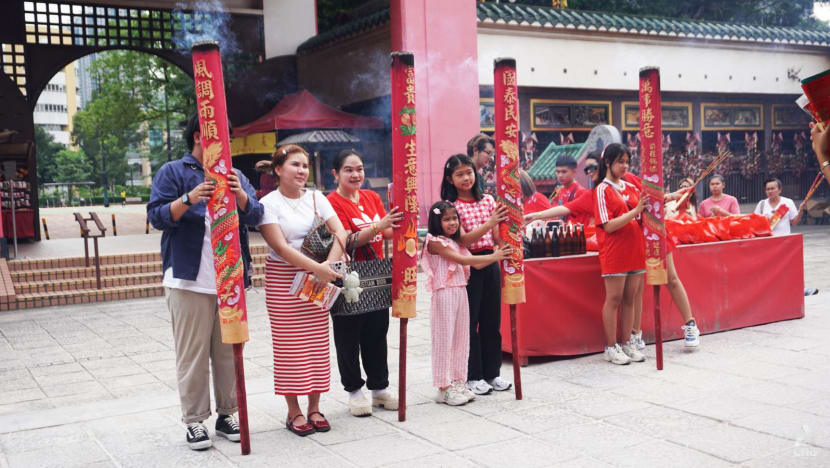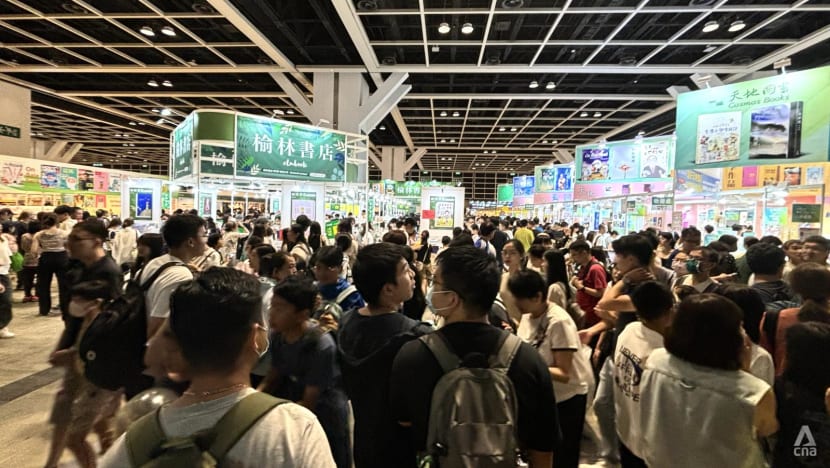Hong Kong is trying to lure travellers from elsewhere beyond the mainland. Who else is on its wishlist?
From religious sites, halal food to the MICE sector - the Hong Kong government is promoting all these and more as it looks to attract visitors beyond the mainland and bolster a pandemic-battered tourism industry. In the second of a two-parter, CNA explores how the city is coping on this front.

Thai tourists holding giant joss sticks they bought at Che Kung Temple in Shatin, Hong Kong in late July 2024. (Photo: CNA/Melody Chan)

This audio is generated by an AI tool.
HONG KONG: The rhythmic chanting of Thai prayers echoes through the air as tourists line up at Hong Kong’s Che Kung Temple in Shatin, each gripping a giant joss stick priced at a cool HK$4,000 (US$510).
They’re there for a simple reason - to pray for health, wealth, and good fortune in general.
Ms Pitayarat Taweehutsawat, 30, and her family of 11 are among them. They’re visiting Hong Kong for the fifth time, always solely for temple visits. This time around, they plan to visit around seven temples over three days.
When asked why they chose Hong Kong as their travel destination, she quickly responded: “Do you believe in fortune?” She explained that a family member’s wishes came true after praying in Hong Kong, so they returned.

Since 2018, Che Kung Temple has provided Thai versions of the God of Wealth and Tai Sui cards to attract Thai tourists. The initiative is in collaboration with the Hong Kong Tourism Board (HKTB), according to the Chinese Temples Committee, which supervises the place.
This is but one facet of a wider drive by the city to woo Southeast Asian tourists - a push that’s growing in strength as changing habits by the traditionally dominant mainland China segment impact local businesses and attractions.
Authorities are also looking to tap other markets, with a particular eye on capturing the lucrative Muslim dollar by expanding halal tourism and carving out the territory as a key destination.
CNA visited Hong Kong in late July, staying in hotels, visiting tourist hotspots and speaking to various industry stakeholders to get a first-hand look.
THE SOUTHEAST ASIAN ALLURE
After Hong Kong reopened its borders last May, Southeast Asia quickly became the city’s second-largest inbound tourism market, retaking its runner-up crown.
According to the Hong Kong Immigration Department, approximately 1.2 million visitors from the region arrived in the first half of 2024, accounting for nearly 6 per cent of the overall tally.
There remains a clear gulf between the numbers from Southeast Asia and those from mainland China, which at about 80 per cent of yearly visitor numbers remains the driving force of Hong Kong tourism.
But the changing face of mainland visitors - leaning towards experiences over expenses - is challenging recovery, while overall arrivals remain significantly below pre-pandemic levels.

Against this backdrop, experts agree that the Southeast Asian market is crucial. The 10 members of the Association of Southeast Asian Nations (ASEAN) collectively form the world’s third-largest population and fifth-largest economy, with a nominal GDP of US$3.6 trillion in 2022.
Mr Johnny Lam, chairman of the Hong Kong Federation of Trade Unions (HKFTU) Tourism Committee, believes the recovery is driven by the normalisation of flights and the desire of families to travel to nearby destinations after the pandemic.
Data from Trip.com shows a 50 per cent increase in flight and train bookings to Hong Kong in the first half of 2024 compared to the same period last year.
"When passenger capacity is limited, airlines prioritise recovery in nearby destinations, leading to more tours from Southeast Asia," Mr Lam explained.
Certain ASEAN countries have been emerging as standouts. Visitor arrivals from the Philippines and Thailand last December reached 116 per cent and 106 per cent of pre-pandemic levels respectively, according to HKTB.
Over 450,000 tourists from Thailand visited Hong Kong last year, double the count in 2018, before mass protests and COVID-19 swept the city.
Based on industry observations, Thais are drawn to Hong Kong's temples and fortune-related tours, while Filipinos favour theme parks like Disneyland. These tourists often forge a more profound connection than making just one-off purchases, leading to repeat visits.

A case in point is Ms Pichayapa Uamongkolkarn, 42, a small and medium enterprise owner from Thailand. Travelling with four family members, she is visiting Che Kung Temple for the seventh time.
“Every time I come to Hong Kong, I have to visit this temple,” she told CNA, explaining that she prays for good fortune like many other visitors.

Ms Pichayapa spent around 20,000 baht (US$570) and stopped by five other temples during her three-day trip.
“Shopping is like a second agenda; the first agenda is to visit the temples,” she said, adding that she only shops if something catches her eye.
Temples are similarly the main focus for fellow Thai Nutpawin Benjakulpat, 22, a TikTok content creator visiting Hong Kong with his mother and sister. Other spending includes buying certain brands of perfumes - cheaper in Hong Kong - and enjoying the local food, he noted.

Since 2018, HKTB has been collaborating with the Chinese Temples Committee, a statutory body which oversees 24 Chinese temples in Hong Kong, to give out free blessing cards in the Thai language to attract Thai tourists.
The committee has also been promoting the city’s temple culture through activities such as fairs, guided tours, workshops, festivals, and social media campaigns.
Accents closer to home also echo at Hong Kong Disneyland, with such attractions proving a key draw for Filipino tourists.
Hong Kong ranks at the top of visa-free destinations frequented by Filipino travellers, according to a list by Agoda. The online travel agency attributed this largely to their familiarity with key attractions, such as Hong Kong Disneyland.
“Hong Kong and Singapore are favourites among Filipino travellers for their seamless accessibility and abundant attractions,” said Mr Mike Hwang, Agoda’s country director for the Philippines.

Hong Kong authorities have made no bones about the importance they place on the Southeast Asian market, be it in tourism or beyond.
The city’s "Hello Hong Kong" campaign was expanded to Malaysia, Singapore, Thailand, and Vietnam in September, offering visitors special vouchers for a gourmet nightlife experience at participating restaurants and bars.
Tourism representatives were also in tow when Hong Kong Chief Executive John Lee visited Laos, Cambodia and Vietnam in late July, his third ASEAN trip in two years.
BANKING ON THE MUSLIM DOLLAR
Hong Kong is also trying to cash in on halal tourism, in the hopes of carving out a growing slice of the billion-dollar global market.
There is much room for growth. Malaysia and Indonesia - both Muslim-majority nations - contributed 1.4 per cent of visitors last year. Middle Eastern countries like the United Arab Emirates and Saudi Arabia made up a mere 0.05 per cent.
HKTB unveiled plans in March to make the city more welcoming to Muslim visitors, including introducing halal guidelines, seminars and practical recommendations.

In June, it organised a seminar titled “Unveiling Potential: Hong Kong as a Muslim-Friendly Travel Destination”. Over 300 people from the tourism industry attended the event at Kowloon Shangri-La hotel, including representatives from leading hotels, restaurants and tour operators.
They were informed about halal, how important it is for a Muslim to follow the concept, and how catering to it could yield economic benefits to Hong Kong.

Businesses like Wu Zhi Jian Beef Noodles in Wanchai are embracing the push. One of Hong Kong’s few halal-certified Lanzhou noodle establishments, its marketing director Li Zhixin told CNA that operations are running smoothly due to “little competition”.
Food supplies are sourced from Ningxia, a province in northeast China with nearly 1.9 million Muslims and where the restaurant’s founder hails from.
At Marouf Cafe in Tsim Sha Tsui, a halal eatery, 25 per cent of the customers are Southeast Asian, with the majority from Indonesia. “Tourists often do their research and come specifically for our coffee. Some even return year after year,” manager Mariam Errabouli told CNA.
Ms Maryam Khan runs an Instagram account with over 21,000 followers that’s dedicated to halal finds across the city. She has noticed a growing awareness of halal cuisine.
“Ten years ago, when I asked for halal, people didn’t know what it was. Now, they understand - some even have halal friends,” said the food blogger in her 20s who grew up in Hong Kong.

At the same time, many challenges remain, Ms Maryam has come across restaurants that have problems getting halal certification as they also sell non-halal food.
One example is Chrisly Cafe, which has six outlets across Hong Kong. Although the food is not halal-certified, the bakery within the eatery offers halal-certified buns and egg tarts.
“That's where the government can come into play and find consultants who can actually advise and help them,” Ms Maryam noted.
Serving up easy access to halal food also remains a key challenge. Despite Hong Kong's 300,000-strong Muslim community, halal-certified eateries are scarce - accounting for only 116 out of nearly 18,000 licensed food outlets in the city.

“I have come across quite a few Muslims - not just Hong Kong residents, but also international students who come to Hong Kong to study. They wouldn't eat halal food just cause it's so hard to find, and then it limits what they can eat,” Ms Maryam pointed out.
Assoc Prof Lisa C Wan from CUHK’s School of Hotel and Tourism Management and Department of Marketing highlighted the importance of offering vegetarian options to accommodate various religious needs.
“Hong Kong is an international destination and a multicultural tourism spot - that should be our selling point, and we should welcome everyone,” she remarked.
To tap into the affluent Middle Eastern market, the Hong Kong government has been promoting its offerings to members of the Gulf Cooperation Council, which comprises Bahrain, Kuwait, Oman, Qatar, Saudi Arabia and the UAE.
Analysts note that these initiatives aim to diversify Hong Kong's economy by building stronger partnerships and attracting more investors and travellers from this key region.
Mr Lam from HKFTU noted that finding tour guides who speak the languages of Middle Eastern countries - such as Arabic or Farsi - is difficult, but efforts are underway to recruit more English-speaking guides.
Assoc Prof Wan noted that while the Southeast Asian and Muslim markets are “growing fast”, mainland visitors remain the dominant segment.
As such, even as Hong Kong strives to tap other markets, it is highly unlikely these efforts will dilute the drive to attract mainlanders, she noted.
CHASING MICE AND OTHER MARKETS
Hong Kong has also been training its sights on rebuilding the key MICE (meetings, incentives, conferences, and exhibitions) sector, which was decimated by the pandemic.
The city welcomed 700,000 MICE travellers in the first half of 2024, about 80 per cent of 2018 levels. Officials project that the number of major events will increase from 150 to over 210 this year, potentially drawing 1.7 million tourists.
MICE travellers are typically bigger spenders, forking out an average of HK$8,000 per visit - 20 per cent to 30 per cent higher than the average spend of other overnight visitors, according to HKTB.
Hong Kong is set to host over 60 MICE events from September to the end of the year, according to Meetings & Exhibitions Hong Kong, a division of HKTB.
Further ahead, the city is set to welcome events like SIGGRAPH Asia, a computer graphics convention, in December 2025. It was last held in Hong Kong in 2013.
The World Cancer Congress and International Federation of Landscape Architects World Congress are among the major events to be held in the territory in 2026.
Beyond chasing MICE, Hong Kong is also looking to tap other markets. The arts scene is one - authorities have been positioning the city as a cultural hub on the global stage by fostering local talent in music, film, fashion and design.

Another is the pink dollar. The city hosted Asia’s first Gay Games in 2023 after months of pandemic-related delays, attracting more than 15,000 participants.
The territory has also been making strides in becoming a more inclusive LGBTQ+ destination, with multiple gay bars, cafes and hangouts listed on the website of Hong Kong’s flag carrier Cathay Pacific.
Walk In Hong Kong, a well-known city walking tour company, also offers an “LGBT in the City” tour that explores the territory’s queer history, along with attractions, shops and landmarks.
HKTB has typically adopted a supporting role in bringing in LGBTQ+ events. For instance, it backed Pink Season when approached by the ground-up initiative in 2011. Branded as Asia’s premier LGBTQ+ festival, its latest edition will take place in October.
Still, the tourism trade union remains cautious about the impact of smaller events.
"You need more than private organisations participating; you need the whole package - an exhibition, a drone show - so people don’t leave right after watching,” said Mr Lam.
“This is how you spur the economy. It requires a plan and collaboration between the government and private entities.”

Assoc Prof Wan noted that while Hong Kong has traditionally emphasised finance, the pandemic highlighted the importance of tourism. “Tourism may contribute only 4 to 8 per cent of GDP, but it creates a ripple effect across infrastructure and employment,” she said.
She suggested that Hong Kong should leverage its East-meets-West reputation to create compelling travel products, citing the popular film "Twilight of the Warriors: Walled In" as an example of a potential launchpad to reel people in and boost business.
The critically-acclaimed martial arts crime action movie is set in Kowloon Walled City, the former site of a Qing Dynasty fort. Assoc Prof Wan explained that many industry players have called for the retaining of the movie set, which cost about HK$50 million (US$6.4 million) to build.
“Many people love the movie after watching it," she said. "If they can preserve the culture and develop supporting infrastructure, such as restaurants, hotels, and convenient transportation, it will be a great tourism zone.”

GETTING THE BASICS RIGHT
Even as Hong Kong pulls out all the stops to boost tourism, analysts agree that fundamentals like infrastructure and connectivity remain pivotal factors.
Hong Kong International Airport (HKG) is working to enhance connectivity to Southeast Asia, signing agreements with airlines and airport operators in the region. These include one with the state-owned operator of Vietnam’s airports and another with Cambodia Airports.
HKG handled 4.3 million passengers in June, up 29.1 per cent year-on-year, and it’s aiming to open more routes and increase flight frequency.
Airlines are already getting in on the action. Hong Kong-based low-cost carrier HK Express launched its first flight to Malaysia in August and is expanding routes to the Philippines, China, and Thailand.
AirAsia's Indonesian subsidiary will start direct flights between Hong Kong in October, along with Jakarta and Bali. Meanwhile, Cathay Pacific will offer daily services to Phnom Penh as part of agreements made during Chief Executive John Lee's visit to Cambodia.
Mr Lam adds that increased flight availability will lower ticket prices and improve accessibility. "If flights transit in Singapore and Thailand, it’s another story. With more flights, ticket prices will drop," he said.
Another critical aspect is making sure their time in Hong Kong goes smoothly.
Mr Simon Lee, an adjunct faculty at Shenzhen Finance Institute, Chinese University of Hong Kong - Shenzhen (CUHK-Shenzhen), emphasised the need for better facilities to enhance the experience - especially for day-trippers.
For instance, designating parking for tour coaches, setting up more public toilets and providing lockers.
“Imagine arriving at a tourist spot by coach, only to face long queues. It wouldn’t be a good experience,” he said.






















